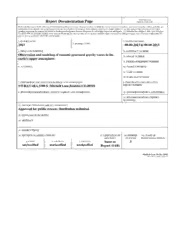
DTIC ADA587974: Observation and Modeling of Tsunami-Generated Gravity Waves in the Earth's Upper Atmosphere PDF
Preview DTIC ADA587974: Observation and Modeling of Tsunami-Generated Gravity Waves in the Earth's Upper Atmosphere
Report Documentation Page Form Approved OMB No. 0704-0188 Public reporting burden for the collection of information is estimated to average 1 hour per response, including the time for reviewing instructions, searching existing data sources, gathering and maintaining the data needed, and completing and reviewing the collection of information. Send comments regarding this burden estimate or any other aspect of this collection of information, including suggestions for reducing this burden, to Washington Headquarters Services, Directorate for Information Operations and Reports, 1215 Jefferson Davis Highway, Suite 1204, Arlington VA 22202-4302. Respondents should be aware that notwithstanding any other provision of law, no person shall be subject to a penalty for failing to comply with a collection of information if it does not display a currently valid OMB control number. 1. REPORT DATE 3. DATES COVERED 2013 2. REPORT TYPE 00-00-2013 to 00-00-2013 4. TITLE AND SUBTITLE 5a. CONTRACT NUMBER Observation and modeling of tsunami-generated gravity waves in the 5b. GRANT NUMBER earth?s upper atmosphere 5c. PROGRAM ELEMENT NUMBER 6. AUTHOR(S) 5d. PROJECT NUMBER 5e. TASK NUMBER 5f. WORK UNIT NUMBER 7. PERFORMING ORGANIZATION NAME(S) AND ADDRESS(ES) 8. PERFORMING ORGANIZATION NWRA/CoRA,3380 S. Mitchell Lane,Boulder,CO,80301 REPORT NUMBER 9. SPONSORING/MONITORING AGENCY NAME(S) AND ADDRESS(ES) 10. SPONSOR/MONITOR’S ACRONYM(S) 11. SPONSOR/MONITOR’S REPORT NUMBER(S) 12. DISTRIBUTION/AVAILABILITY STATEMENT Approved for public release; distribution unlimited 13. SUPPLEMENTARY NOTES 14. ABSTRACT 15. SUBJECT TERMS 16. SECURITY CLASSIFICATION OF: 17. LIMITATION OF 18. NUMBER 19a. NAME OF ABSTRACT OF PAGES RESPONSIBLE PERSON a. REPORT b. ABSTRACT c. THIS PAGE Same as 3 unclassified unclassified unclassified Report (SAR) Standard Form 298 (Rev. 8-98) Prescribed by ANSI Std Z39-18 DISTRIBUTION STATEMENT A. Approved for public release; distribution is unlimited. Observation and modeling of tsunami-generated gravity waves in the earth’s upper atmosphere Sharon L. Vadas NWRA/CoRA 3380 S. Mitchell Lane Boulder, CO 80301, USA phone:(303) 415-9702x202 fax: (303) 415-9702 email: [email protected] Award Number: N00014-13-1-0475 http://www.cora.nwra.com/~vasha/ LONG-TERM GOALS To determine the response of the 630 nm airglow in the thermosphere to gravity waves excited by ocean tsunami. OBJECTIVES To build a compatible set of models which 1) calculate the atmospheric gravity waves (GWs) excited by a tsunami, 2) propagate these GWs into the thermosphere, and 3) reconstruct the GW field in the thermosphere (e.g., neutral wind, density and temperature perturbations caused by the GWs) as a function of space and time. These perturbations will then be given to Dr. Makela's group in order to calculate the 630 nm airglow response to these GWs. APPROACH Dr. Vadas has already built a similar set of models for GWs excited by deep convective plumes previously. However, these models cannot be simply applied here, because 1) the GWs excited by deep convective plumes require a different analytic model (plane wave versus a single “impulse” for convective plumes), and 2) convective plumes are pinpoint sources, unlike tsunamis. Our approach is to first derive analytically the Fourier-Laplace compressible solutions to GWs excited by a plane wave. (A tsunami can be decomposed as a sum of plane waves.) These solutions are in spectral space. We will then “sprinkle” these GWs in x,y space (regular or random). We will then ray trace these GWs into the thermosphere, and reconstruct the GW field there. Note: this latter model is the same as that for the convective plumes, and is therefore “done”. WORK COMPLETED 1 Before beginning work on deriving the GW solutions, we first needed to perform a literature search in order to understand what was done previously. We have now fully completed this task. In doing so, we determined what we would like to include in our models that was not included previously. For example, one model only solved the Boussinesq equations in a non-viscous thermosphere. We decided that it would be better to solve the compressible equations, because the phase speeds of the excited GWs were near the speed of sound in the atmosphere, and therefore errors would like occur if only calculating the Boussinesq solutions. Additionally, our ray trace model automatically takes into account the extremely important effect of viscous dissipation in the thermosphere. Another model solved the steady state solutions. But a tsunami is a transient source. We are therefore using a ray trace model which solves wave packet (not steady state) solutions. We then set up our equation set, which is the compressible, Navier Stokes equations in the presence of a plane wave vertical force. This force models the displacement of the air directly above the moving ocean tsunami. We then linearized these equations, and solved them using Fourier-Laplace techniques. These are the same techniques we used previously (Vadas, JGR, 2013). We checked that these solutions were correct by plugging them back into the original linearized equations. These solutions were presented at our recent CoRA/NWRA site review. RESULTS The Fourier-Laplace analysis shows that there are “two” GW solutions. One is GWs which have the same wave period as the tsunami (i.e., “forced” waves). The other is “free” GWs which have a spectrum of different wave periods and scales. These second set of GWs have not been modeled previously, because previous models were more heuristically-based. Because GWs with periods that do not match the tsunami period have been observed in the 630 nm layer, it is possible that these second set of GWs may be able to better explain these observations. Thus, they may be quite important for understanding the complexity of the observations. IMPACT/APPLICATIONS Because we are building a more realistic set of GW excitation and propagation models, our GW solutions may provide for a much better understanding of how tsunamis affect the 630 nm airglow layer. This would greatly enhance our ability to detect tsunamis in the 630 nm airglow layer and in the ionosphere in general. RELATED PROJECTS Not at this time. 2
